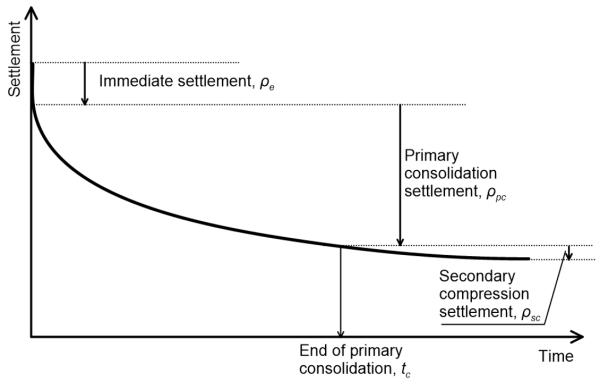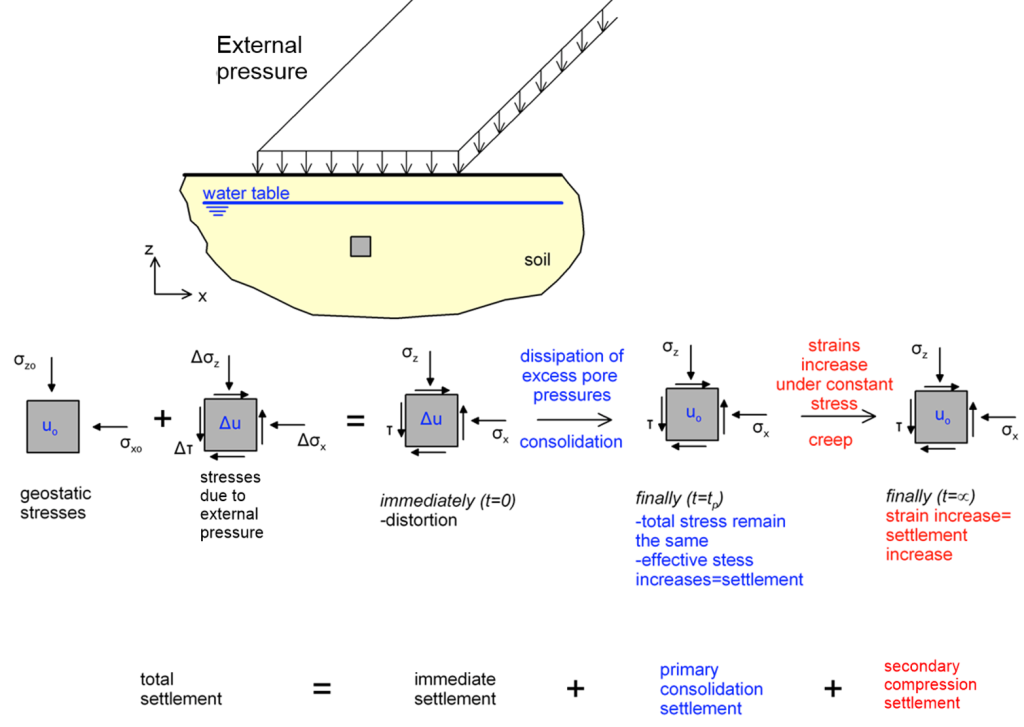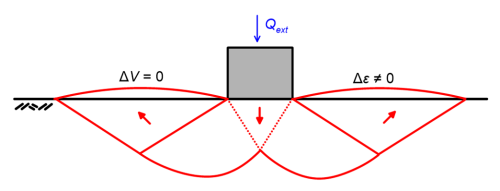4.4 Components of settlement due to structural loading
When estimating settlement, one should always keep in mind that application of external loadings to soil results in total stress increments, whereas settlement due to external loading are due to changes in effective stress only. The total settlement that will develop following the application of a load or pressure on the soil can be broken down into three components, with respect to their evolution with time (Figure 4.7):
- Immediate settlement, ρe
- Primary consolidation settlement, ρpc
- Secondary compression settlement or creep, ρsc
Immediate settlement (often referred to as elastic settlement) develops instantaneously, while primary consolidation and secondary compression settlement are time-dependent (Figure 4.7). The total settlement will be equal to the sum of the three settlement components as:
(4.1) ![]()
To understand the mechanism of settlement development, consider an external pressure applied on the ground surface, and a soil particle below the groundwater table (Figure 4.8). Initially, only geostatic stresses are applied on the soil particle, and the pore pressure u0 is the hydrostatic pore water pressure. After the pressure is applied, total stresses increase. We can calculate these total stresses according to the methods described in Part 3.


If the soil features high permeability (coarse grained, sand or gravel), then the external pressure will be transferred immediately to the soil skeleton. The effective stress after the application of the pressure will be:
(4.2) ![]()
where σ′z0 is the initial, geostatic effective stress, and Δσz is the additional stress due to the application of the pressure. Pore water pressure does not change, and it remains equal to the hydrostatic pore water pressure. This type of behavior is called drained. Immediate settlement that will develop instantaneously after the application of the pressure will be equal to the total settlement in this case.
However, if the soil features low permeability (fine grained, clay) and is saturated, initially the additional stresses due to the external pressure will be resisted by the development of excess pore water pressure Δu, and effective stresses will remain unchanged. If we assume 1-D loading conditions i.e., lateral soil strain is equal to zero, then:
(4.3) ![]()
(4.4) ![]()
When soil permeability is low, the generated pore water pressure cannot dissipate fast enough as the soil tends to deform, so excess pore water pressure Δu develops. This type of behaviour is called undrained. Some insight on the origin of the terms drained and undrained, which the reader may erroneously associate with drainage/pumping of water, is provided in Section 5.2.5. Shear distortion due to the application of the pressure e.g., from a shallow footing takes place without volume change ΔV = 0 under undrained conditions (Figure 4.9). Zero volume change however does not necessarily mean zero deformation, as in the case of 1-D consolidation. Rather, in 3-D conditions below a shallow footing lateral strains are not restricted, and immediate settlement will indeed develop, but will be combined with heave of soil around the footing (Figure 4.9). In that case Eq. 4.4 is not valid, and the developing excess pore pressure will be lower, exactly due to the development of lateral strains.

As time passes, the excess pore water pressure that developed due to the application of the pressure dissipates gradually, at a rate which depends on the permeability of soil. As excess pore pressure Δu dissipates, effective stresses increase, and the loading is gradually transferred to the soil skeleton. Remember that total stresses remain constant, and equal to the geostatic total stresses plus the additional stresses due to the external loading:
(4.5) ![]()
(4.6) ![]()
Increase of effective stress results to soil deformation, and to the development of primary consolidation settlement (Figure 4.7).
After “enough” time t = tc, excess pore water pressure will become zero Δu = 0, and the additional stress from the external loading will be transferred to the soil skeleton. At this point the primary consolidation has been completed, and the primary consolidation settlement has reached its final value (Figure 4.7).
Secondary compression settlement concerns mainly organic soils and soft clays. One mechanism (referred to as Hypothesis A) proposed in the literature to describe and quantify secondary compression is that, after the end of primary consolidation, strains (and thus settlement) continue to increase under constant effective stress, due to changes in soil structure associated with creep. It must be stated here that other researchers (of which the author is one) argue that the mechanisms of creep and consolidation are concurrent (Hypothesis B). Exploring this further is beyond the scope of this Part. Secondary compression settlement is usually neglected in sands yet, in some organic soils like fibrous peat, a large proportion of total settlement is due to secondary compression.
Summarising, depending on the nature of the soil, some of the components of total settlement can be zero:
- For sands primary consolidation and secondary compression settlement is usually neglected ρpc ≈ ρsc ≈ 0, so total settlement is equal to immediate settlement ρ = ρe.
- For most stiff clays, secondary compression settlement is neglected too ρsc ≈ 0.

